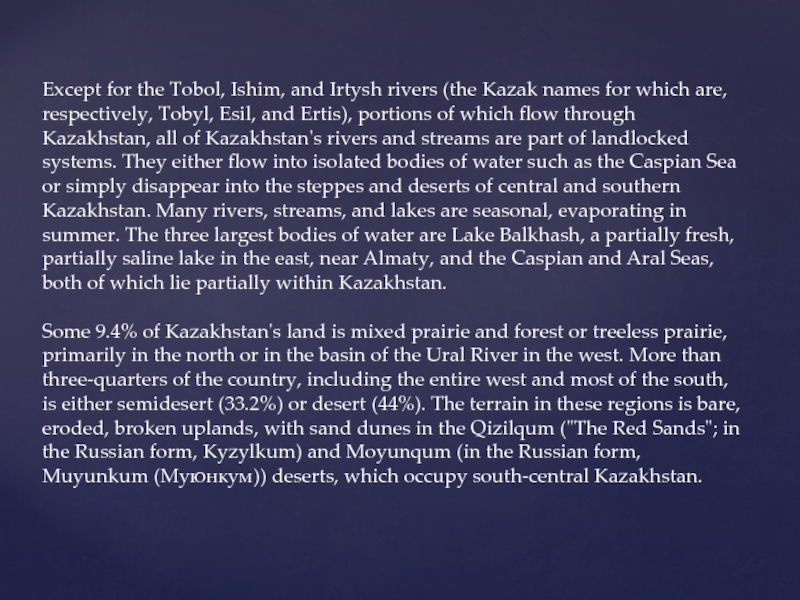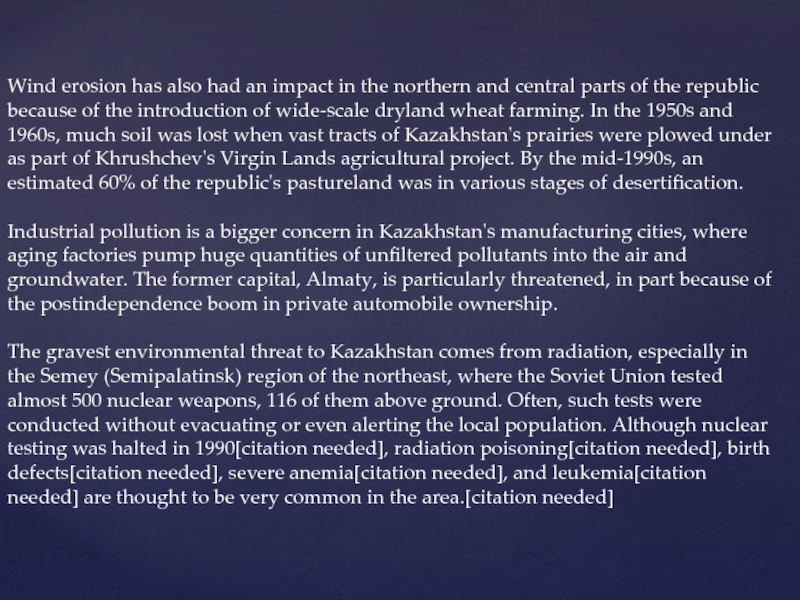Слайд 1 Kazahstan geography
Arystanova Laura
BO-13
Слайд 2Kazakhstan is located in Central Asia and Eastern Europe at
48°N 68°ECoordinates: 48°N 68°E. With an area of about 2,724,800
square kilometers, Kazakhstan is more than twice the combined size of the other four Central Asian states, or about twice the size of Alaska. The country borders Turkmenistan, Uzbekistan, and Kyrgyzstan to the south; Russia to the north; Russia and the Caspian Sea to the west; and China's Xinjiang Uygur Autonomous Region to the east.
Слайд 3There is considerable topographical variation within Kazakhstan. The highest point
is the top of the mountain Khan Tengri, on the
Kyrgyz border in the Tian Shan range, with an elevation of 7,010 meters, or 21,999 feet above sea level; the lowest point is the bottom of the Karagiye depression at 132 meters, or 433 feet below sea level, in the Mangystau province east of the Caspian Sea. Most of the country lies at between 200 and 300 meters above sea level, but Kazakhstan's Caspian shore includes some of the lowest elevations on Earth. The peak Khan Tengri in the Tian Shan Mountains (and on the border with Kyrgyzstan and China) is Kazakhstan highest elevation at 6995m (7010m with ice cap).
Many of the peaks of the Altay and Tien Shan ranges are snow-covered year-round, and their run-off is the source for most of Kazakhstan's rivers and streams.
Слайд 4Except for the Tobol, Ishim, and Irtysh rivers (the Kazak
names for which are, respectively, Tobyl, Esil, and Ertis), portions
of which flow through Kazakhstan, all of Kazakhstan's rivers and streams are part of landlocked systems. They either flow into isolated bodies of water such as the Caspian Sea or simply disappear into the steppes and deserts of central and southern Kazakhstan. Many rivers, streams, and lakes are seasonal, evaporating in summer. The three largest bodies of water are Lake Balkhash, a partially fresh, partially saline lake in the east, near Almaty, and the Caspian and Aral Seas, both of which lie partially within Kazakhstan.
Some 9.4% of Kazakhstan's land is mixed prairie and forest or treeless prairie, primarily in the north or in the basin of the Ural River in the west. More than three-quarters of the country, including the entire west and most of the south, is either semidesert (33.2%) or desert (44%). The terrain in these regions is bare, eroded, broken uplands, with sand dunes in the Qizilqum ("The Red Sands"; in the Russian form, Kyzylkum) and Moyunqum (in the Russian form, Muyunkum (Муюнкум)) deserts, which occupy south-central Kazakhstan.

Слайд 5Climate
The Climate in Kazakhstan is continental. In summer the temperatures
average more than 30 °C (86 °F) and in winter
average −20 °C (−4.0 °F).[1]
Слайд 6The environment of Kazakhstan has been badly damaged by human
activity. Most of the water in Kazakhstan is polluted by
industrial effluents, pesticide and fertilizer residue, and, in some places, radioactive elements. The most visible damage has been to the Aral Sea, which as recently as the 1970s was larger than any of the Great Lakes of North America save Lake Superior. The sea began to shrink rapidly when sharply increased irrigation and other demands on the only significant tributaries, the Syr Darya and the Amu Darya (the latter reaching the Aral from neighboring Uzbekistan), all but eliminated inflow. During the Soviet Era, Kazakhstan received water from Tajikistan and Kyrgyzstan, and Kazakhstan, Turkmenistan, and Kazakhstan provided oil and gas for these two nations in return. However, after the collapse of the USSR this system had collapsed and no plan to replace this system has been put in place. According to research conducted by the International Crisis Group, there is little political will to solve this problem despite Central Asia's need for mutual resource-sharing.[2] By 1993 the Aral Sea had lost an estimated 60% of its volume, in the process breaking into three unconnected segments.

Слайд 7Increasing salinity and reduced habitat have killed the Aral Sea's
fish, hence destroying its once-active fishing industry, and the receding
shoreline has left the former port of Aral'sk more than seventy kilometers from the water's edge. The depletion of this large body of water has increased temperature variations in the region, which in turn have had an impact on agriculture. A much greater agricultural impact, however, has come from the salt- and pesticide-laden soil that the wind is known to carry as far away as the Himalaya Mountains and the Pacific Ocean. Deposition of this heavily saline soil on nearby fields effectively sterilizes them. Evidence suggests that salts, pesticides, and residues of chemical fertilizers are also adversely affecting human life around the former Aral Sea; infant mortality in the region approaches 10% compared with the 1991 national rate of 2.7%.
Слайд 8By contrast, the water level of the Caspian Sea has
been rising steadily since 1978 for reasons that scientists have
not been able to explain fully. At the northern end of the sea, more than 10,000 square kilometres of land in Atyrau Province have been flooded. Experts estimate that if current rates of increase persist, the coastal city of Atyrau, eighty-eight other population centers, and many of Kazakhstan's Caspian oil fields could be submerged by 2020.
Слайд 9Wind erosion has also had an impact in the northern
and central parts of the republic because of the introduction
of wide-scale dryland wheat farming. In the 1950s and 1960s, much soil was lost when vast tracts of Kazakhstan's prairies were plowed under as part of Khrushchev's Virgin Lands agricultural project. By the mid-1990s, an estimated 60% of the republic's pastureland was in various stages of desertification.
Industrial pollution is a bigger concern in Kazakhstan's manufacturing cities, where aging factories pump huge quantities of unfiltered pollutants into the air and groundwater. The former capital, Almaty, is particularly threatened, in part because of the postindependence boom in private automobile ownership.
The gravest environmental threat to Kazakhstan comes from radiation, especially in the Semey (Semipalatinsk) region of the northeast, where the Soviet Union tested almost 500 nuclear weapons, 116 of them above ground. Often, such tests were conducted without evacuating or even alerting the local population. Although nuclear testing was halted in 1990[citation needed], radiation poisoning[citation needed], birth defects[citation needed], severe anemia[citation needed], and leukemia[citation needed] are thought to be very common in the area.[citation needed]

Слайд 10With some conspicuous exceptions, lip service has been the primary
official response to Kazakhstan's ecological problems. In February 1989, opposition
to Soviet nuclear testing and its ill effects in Kazakhstan led to the creation of one of the republic's largest and most influential grass-roots movements, Nevada-Semipalatinsk, which was founded by Kazak poet and public figure Olzhas Suleymenov. In the first week of the movement's existence, Nevada-Semipalatinsk gathered more than 2 million signatures from Kazakhstanis of all ethnic groups on a petition to Mikhail Gorbachev demanding the end of nuclear testing in Kazakhstan. After a year of demonstrations and protests, the test ban took effect in 1990. It remained in force in 1996, although in 1995 at least one unexploded device reportedly was still in position near Semey.
Слайд 11Once its major ecological objective was achieved, Nevada-Semipalatinsk made various
attempts to broaden into a more general political movement; it
has not pursued a broad ecological or "green" agenda. A very small green party, Tabigat, made common cause with the political opposition in the parliament of 1994.
Слайд 12The government has established a Ministry of Ecology and Bioresources,
with a separate administration for radioecology, but the ministry's programs
are underfunded and given low priority. In 1994 only 23% of budgeted funds were actually allotted to environmental programs. Many official meetings and conferences are held (more than 300 have been devoted to the problem of the Aral Sea alone), but few practical programs have gone into operation. In 1994 the World Bank, the International Monetary Fund (IMF), and the United States Environmental Protection Agency agreed to give Kazakhstan US$62 million to help the country overcome ecological problems.